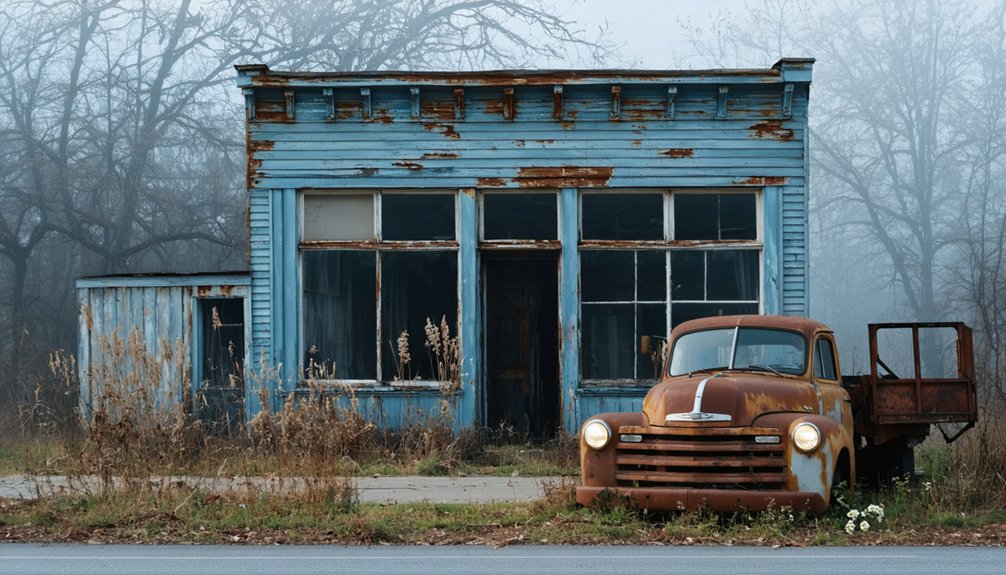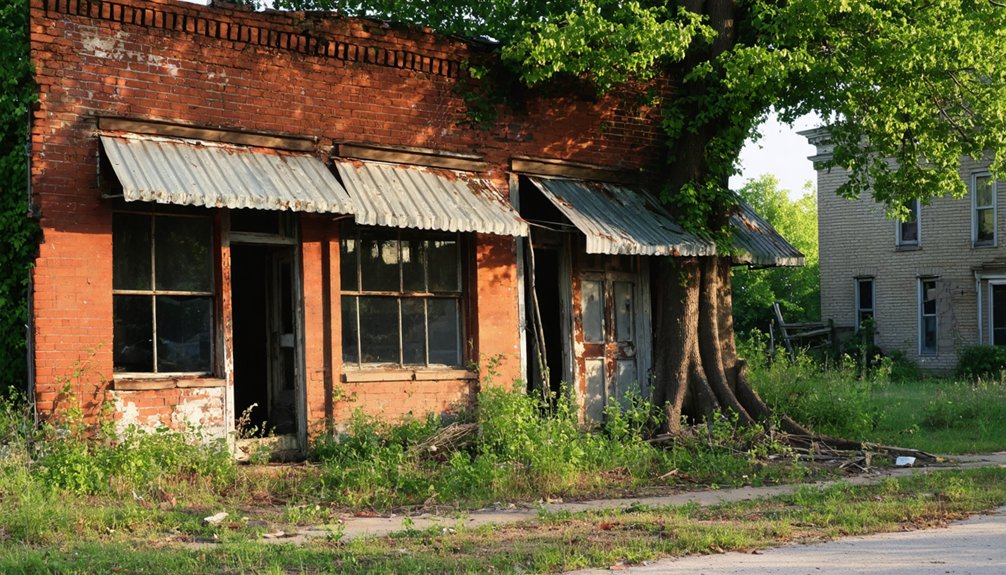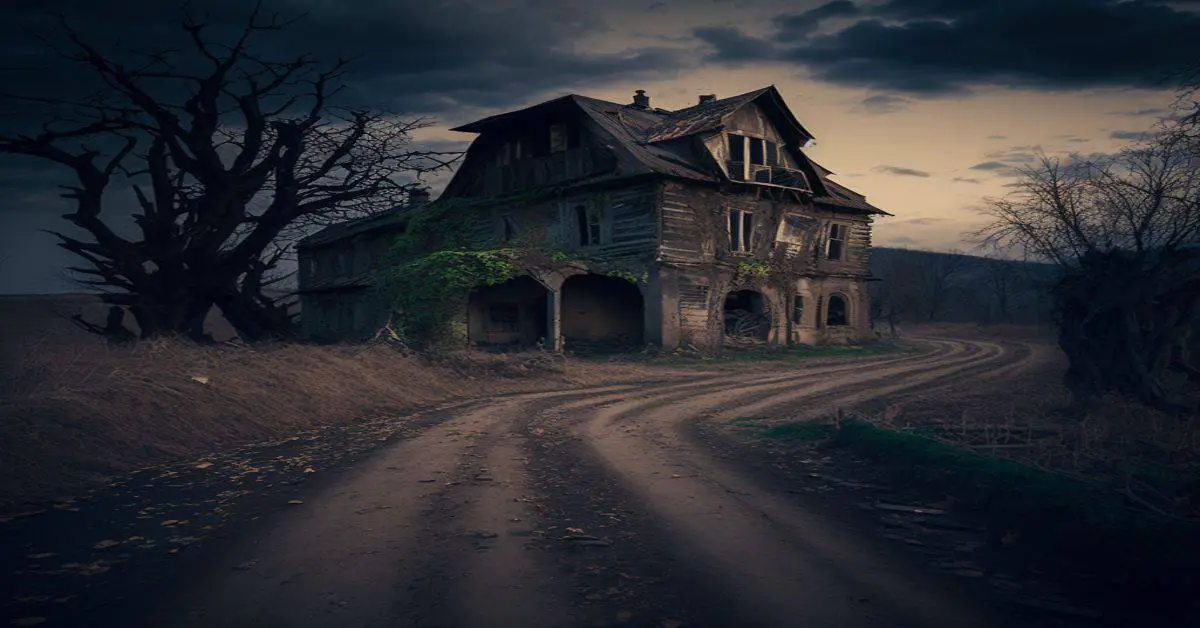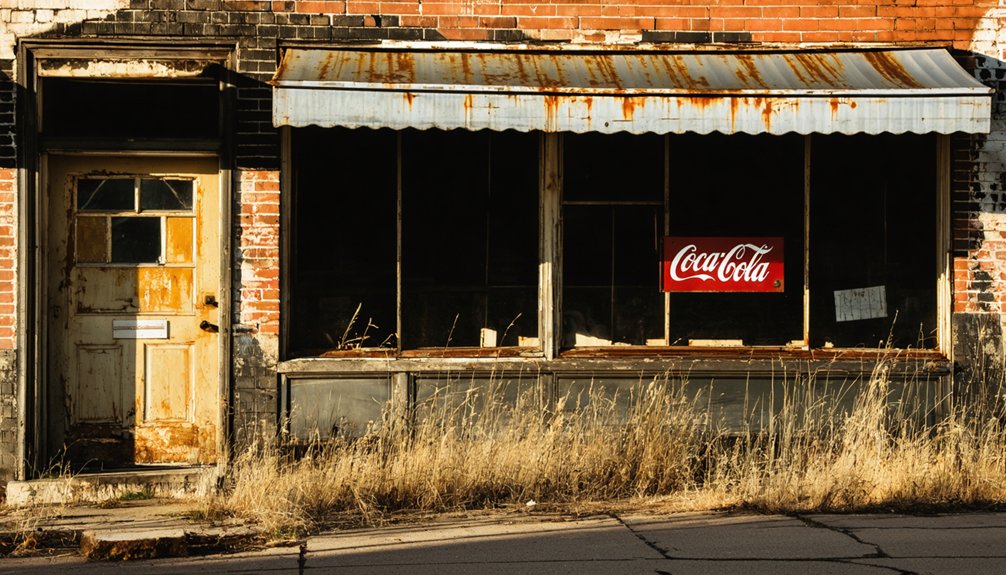You’ll discover Old Evansville’s ghost town remains nestled along the Kaskaskia River, where Andrew White established this settlement in 1811. Unlike neighboring mining communities, it first flourished through agriculture and river commerce before coal mining transformed its destiny. The town’s abandoned strip mines and crumbling foundations now whisper stories of hardy miners who once descended daily into the earth’s depths, while nature slowly reclaims what was once a bustling coal company settlement. Its hidden pathways hold countless tales waiting to be unearthed.
Key Takeaways
- Established in 1811 along the Kaskaskia River, Evansville was initially an agricultural and river commerce settlement before becoming a coal mining town.
- The town’s formal layout was designed by Cadwell Evans in 1834, featuring a compact footprint of 0.817 square miles with waterfront access.
- Mining operations began in the 1850s with the Bodiam Coal Company, using room and pillar techniques to extract coal beneath Reitz Hill.
- Miners lived in company-owned houses, working grueling shifts underground for minimal wages while maintaining strong community bonds through shared hardships.
- The town declined when coal seams thinned, leading to population loss, with only foundations and cellar holes remaining as nature reclaimed the area.
The Mining Town’s Origins
Looking back to 1811, the story of Evansville, Illinois, began when Andrew White first gazed upon the pristine banks of the Kaskaskia River and recognized its potential.
You’ll find that unlike many frontier settlements of that era, Evansville’s roots weren’t tied to mining or indigenous trading posts – it was the river that called to early settlers.
The settlement patterns of Evansville history reveal a modest but determined community focused on agriculture and river commerce. In 1834, Cadwell Evans designed and established the formal layout of the village streets and lots.
While other Illinois towns experienced explosive growth from coal booms, your ancestors who chose Evansville carved out a different path. This stood in stark contrast to northern Illinois towns like Coal City and Braidwood that emerged after 1864 when coal was discovered.
They built their future around the flowing waters of the Kaskaskia, establishing a small but resilient village that would never grow beyond 900 souls but would maintain its independent spirit for generations to come.
Life in a Coal Company Settlement
If you’d lived in Evansville during its mining heyday, you’d have risen before dawn to join your fellow miners for grueling shifts underground, where the rhythmic sounds of pickaxes and coal cars echoed through the shafts.
Your modest company-owned home, though lacking modern amenities, would’ve been a refuge where your family gathered around the coal stove, sharing meals bought on credit from the company store.
Working ten-hour days, you’d have earned about $190 annually, barely enough to cover the tools and transportation costs required for the job.
You’d have found strength in your tight-knit community of immigrant neighbors, who looked after one another’s children, shared traditional celebrations, and stood together during strikes and hardships.
Daily Mining Work Routines
When dawn broke over the Illinois coalfields in the late 1800s, miners would already be gathering at the colliery, their carbide lamps flickering in the pre-morning darkness as they collected their tools and assignments for another grueling day underground.
You’d descend into the earth’s depths via cage or stairs, joining your partner to begin the day’s work. Your mining techniques would include swinging picks and shovels until your muscles ached, setting charges after dynamite’s arrival, and carefully propping timber supports to prevent cave-ins. The room and pillar method became the standard approach for extracting coal while maintaining mine stability.
The daily routines were relentless – pushing loaded coal cars along narrow rails, clearing debris, and checking for deadly gases. You’d work from sunup to sundown, six days a week, earning your pay by the ton. These mines, typically running 30 to 200 feet deep, required constant vigilance from workers.
Every lump of coal meant another step toward freedom from poverty, though the price was steep in sweat and danger.
Housing and Family Life
After those long days underground, you’d return home to one of those identical company houses lining the settlement streets – simple frame cottages that miners called home as long as they kept working the coal.
The housing conditions were modest at best – basic amenities, cramped spaces, and little room for personalization. Yet within those walls, family dynamics thrived as generations shared stories around dinner tables and children played in dusty yards. The Bodium Coal Company established this mining community when operations began in 1858.
Your wife might’ve taken in laundry or sewing to help make ends meet while managing the household. Extended family often lived nearby, creating a tight-knit support network.
You’d get your groceries at the company store, send your kids to the company school, and gather with neighbors at the local church. Life wasn’t easy, but those humble homes fostered resilient family bonds that defined our mining heritage.
Community Support Networks
Despite the hardships of coal mining life, you could always count on your neighbors to pull together when times got tough. The social bonds you’d forge in Evansville weren’t just friendships – they were lifelines.
When a miner got injured or fell ill, you’d find families taking turns bringing hot meals, watching children, or picking up extra shifts to help make ends meet.
Your community’s resilience showed in the way folks organized through churches and brotherly organizations, creating a safety net that the company store couldn’t provide.
During strikes or wage disputes, you’d see miners’ wives coordinating food drives while union leaders fought for better conditions.
These networks of mutual support weren’t just about survival – they were about standing together, preserving dignity, and building a future worth fighting for.
Location and Geography
You’ll find Old Evansville nestled along the banks of the Saline River, just a mile south of present-day Equality in Gallatin County, Illinois.
Like many ghost town sites in Illinois, Old Evansville now stands as a testament to economic decline and community relocation.
The town’s strategic position near the river made it a prime settlement for coal mining operations, with Jones Lake Road now serving as your gateway to this historic site.
The surrounding hills, dotted with abandoned strip mines, stand as silent sentinels to the region’s rich coal-mining heritage, while the nearby three-way crossing marks what was once a bustling coal company community. Today, the area features just four residences scattered across the landscape.
River Access Settlement
Nestled along the banks of the historic Kaskaskia River, Old Evansville carved out its place as a quintessential river settlement in Randolph County, Illinois.
You’ll find this freedom-loving town strategically positioned where limestone bluffs meet gentle riverbanks, making it perfect for river trade and historical navigation. The settlement’s compact footprint of 0.817 square miles tells a story of pioneers who knew the importance of waterfront access. Much like its Indiana namesake situated on an oxbow in Ohio River, the town’s location proved ideal for maritime commerce.
- The village’s streets aligned with the river’s flow, maximizing access to crucial water routes
- Settlers chose higher ground near the riverbank, balancing flood protection with commerce
- Docks and landings once dotted the shoreline, connecting Evansville to a network of river towns
The Kaskaskia’s waters shaped not just the town’s geography, but its very soul and spirit.
Mining Town Coordinates
Standing proudly in southwestern Illinois, Old Evansville‘s coordinates pin this historic mining town near latitude 37.977° N and longitude -87.551° W.
You’ll find this remarkable ghost town nestled in a landscape perfectly suited for mining technology, with gentle hills rising just 10 feet between contours and rich coal seams waiting beneath layers of shale and sandstone.
The town’s strategic position near the Ohio and Wabash Rivers made coal transportation a breeze, connecting miners to bustling markets across the Midwest. Similar to Mason, Ohio, the town’s location offered excellent transportation advantages for industry.
You can still trace the old rail lines and canal routes that once served as lifelines for this thriving community.
The surrounding terrain, dotted with tributary streams and accessible timber stands, supported the innovative mining operations that made Old Evansville a cornerstone of Illinois’ industrial heritage.
Mining Operations and Local Industry

As the rich coal seams beneath Reitz Hill beckoned to early prospectors, mining operations transformed Evansville’s landscape beginning in the 1850s.
You’ll find the pioneering spirit of the Bodiam Coal Company‘s first shaft in 1858, where hardy miners wielded picks and shovels in the “room and pillar” technique that would shape the region’s destiny. The economic impact rippled through the community, connecting your hometown to bustling markets in St. Louis and Chicago.
- Underground mining created a web of tunnels beneath your feet, where determined crews carved out chambers using time-tested mining techniques.
- Your ancestors’ sweat equity built a thriving economy around these coal operations, supporting local furnaces and creating countless jobs.
- This industrial heritage flows through your veins, even as the mines now stand silent beneath the Illinois prairie.
Community Infrastructure and Services
While the coal mines formed Evansville’s beating heart, the town’s intricate web of infrastructure brought life to its muddy streets and bustling neighborhoods.
You’d find the railroad depot standing proudly on Church Street, where coal-laden cars and passenger trains connected your town to the wider world. The Wabash and Erie Canal briefly offered another lifeline, powering local industry until the iron horse proved superior.
Public utilities, powered by local coal, lit up homes and businesses while community services kept the town running smoothly.
Even when floods threatened to wash away your dreams, FEMA and IEMA stepped in to help rebuild. You’d have seen the town’s resilience in action as streets reopened and services returned, proving that Evansville’s spirit couldn’t be dampened by nature’s fury.
The Path to Abandonment

The story of Old Evansville’s decline reads like many small mining towns across Illinois – a tale etched in coal dust and hope. As coal seams thinned and strip mines closed, you’d have witnessed families packing up their dreams along with their belongings, seeking brighter futures elsewhere.
Economic challenges rippled through the community like aftershocks, shuttering local businesses and dimming the town’s essence.
- Migration trends saw young folks heading to railroad towns and cities, where opportunities beckoned beyond the coal-dusted horizons.
- Without new industry to replace mining, the town’s lifeblood slowly drained away.
- The isolated location, marked by dirt roads and the old Saline River bridge, sealed the town’s fate.
Today, only scattered remnants whisper stories of the once-thriving mining community that called these hills home.
Present-Day Remnants
Three ghostly traces of Old Evansville’s glory days still linger among the overgrown Illinois countryside.
You’ll find decaying foundations and cellar holes scattered across the landscape, silent witnesses to the homes and businesses that once thrived here. Metal tools and historical artifacts occasionally surface after spring rains, whispering tales of daily life in this forgotten community.
Broken bricks and rusty relics emerge from rain-soaked soil, telling stories of bustling streets now lost to time.
Nature has reclaimed much of what mankind built, with seasonal floods reshaping the lower grounds and wildlife making homes where families once dwelt.
While you won’t find many standing structures today, you can still trace the old pathways between stone fragments and crumbling brickwork.
Local historians have mapped these remnants using modern technology, preserving the memory of this proud Illinois town for future generations to discover.
Legacy of Old Evansville’s Rise and Fall

Deep in southern Illinois’ coal country, Old Evansville‘s story mirrors countless mining towns that rose and fell with America’s industrial heartbeat.
You’ll find its economic impact woven into the fabric of Saline County, where coal miners once carved their living from the rich earth. Their cultural heritage lives on in the remnants of this 1920s community, where determined families built their dreams around the promise of black gold.
- The town exemplifies the fierce independence of mining communities that shaped America’s energy landscape
- Its boom-and-bust cycle serves as a powerful reminder of the true cost of progress
- The ghost town stands as a symbol of the resilient spirit of Illinois coal country families
Today, you’re walking through more than abandoned streets – you’re experiencing a chapter of American industrial courage.
Frequently Asked Questions
Were There Any Notable Accidents or Disasters in Old Evansville’s Mines?
You’d remember several devastating historical accidents, like Sunnyside Coal Mine’s explosion killing 25-30 miners underground, while Old Ben No. 8’s mine safety failures led to multiple blasts including one claiming 26 lives.
What Happened to the Mining Equipment After the Town Was Abandoned?
You won’t find mining relics in Old Evansville today – they scrapped, sold, or relocated equipment as operations ceased. Without historical preservation efforts, machinery likely went to other active mines or scrapyards.
Did Any Families From Old Evansville Establish Settlements Elsewhere?
You’ll find many mining families followed typical settlement patterns, relocating to nearby towns like Equality or establishing new communities along railways and higher ground, preserving their cherished ties to home.
What Were the Average Wages for Miners in Old Evansville?
If you’d worked the mines like Joe Smith did, you’d have earned around $2.56 daily in 1910, rising to $7.50 by 1919. Mining conditions were tough, but wages compared well against other jobs.
Were There Any Attempts to Revive the Town for Non-Mining Purposes?
You won’t find any documented revival efforts or community initiatives to transform the town beyond mining – it’s just faded quietly into Illinois history, leaving one lone house standing.
References
- https://www.youtube.com/watch?v=93k0qtvzkn4&vl=en-US
- https://www.heraldtimesonline.com/story/lifestyle/home-garden/2021/01/15/some-illinois-ghost-towns/43846097/
- https://www.courierpress.com/story/entertainment/2018/10/30/here-5-true-evansville-ghost-stories/1730979002/
- https://www.evansvilleil.org/history.html
- https://drloihjournal.blogspot.com/p/lost-towns-of-illinois-series.html
- https://www.indianalandmarks.org/2020/10/looking-at-wartime-landmarks-in-evansville/
- https://wanderlog.com/place/details/718843/shawneetown-bank
- https://www.ghosttowns.com/states/il/oldevansville.html
- https://en.wikipedia.org/wiki/List_of_ghost_towns_in_Illinois
- https://en.wikipedia.org/wiki/History_of_Evansville



